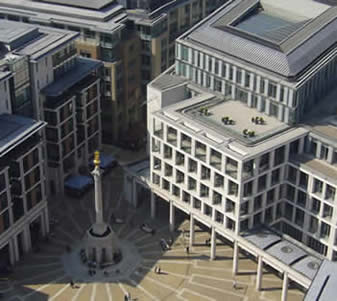
Meet the AIM Players...
The London Stock Exchange
In this series we are looking at the various players that make up the AIM marketplace. Previously we have looked at the roles of the Financial PR Company and the Nomad. Today we are looking at a particularly important player, the London Stock Exchange (LSE), the owner and regulator of AIM.
The London Stock Exchange (LSE) traces its history back to the coffee houses of 17th century London. However, it was only in 2001 that the LSE itself became a listed company on its own Main Market. Launched in 1995 AIM is a fairly recent innovation in the 300+ year history of the Exchange. To see more on the history of the LSE please click here.
There are many misconceptions about the LSE and AIM. A common one is that the LSE still has a trading floor – in fact, they have not had one for more than 20 years. Apparently, the LSE get calls every day from people wanting to see the trading floor! Another misconception is that AIM is something apart from the Stock Exchange. As we will see, it is an integral part of the Exchange’s offering.
The LSE and AIM
I met with Mark Fahy of the LSE to discuss the LSE’s role in the AIM market. Mark is a Senior Manager at the LSE responsible for the Small and Mid Cap Team. I asked Mark to describe the services that the LSE provides to AIM companies. In summary these are:-
- Assistance with AIM Regulations
- Training for AIM Directors and Senior Management
- Advice and Guidance on specific issues
- Advice on Investor Relations
- Investor Relations website tools
- Advice on Corporate Governance
- Seminars and Conferences
- RNS and RNS Reach news services
- Trading Platforms – SETS,SETSQX and SEAQ
click here to learn more about LSE trading platforms
The basic annual fee that AIM companies pay for these services is £4750 per annum. In addition, there may be additional fees for specific services. On joining the market companies are required to pay an admission fee which is calculated according to the size of the company at admission. For example, a company joining with a market capitalisation of £20 million would be required to pay an admission fee of £11,700.
One thing you will see that is not on the list of LSE responsibilities is dealing with investors’ complaints about share dealing irregularities. These are dealt with by the Financial Services Authority.
AIM Rules
At the LSE there is an AIM Regulation team of 12 people, including lawyers, accountants and corporate finance specialists. This team provides advice and guidance on the AIM Rules and monitors compliance with the rules. Much of the work of this team involves working with Nomads - the AIM Regulation team is also being responsible for approving and monitoring Nomads.
The Nomads are effectively working as agents for the LSE ( See Aimzine’s article on the role of the Nomad here. When a company first floats on the market, the Nomad does most of the set up work. Indeed, sometimes the LSE will not receive notice that a company intends to admit to AIM until the firm files its statutory “10 day announcement” before coming to market.
I asked Mark Fahy to explain the differences between the rules for AIM companies and those for Main Market companies. The key distinction is that AIM has its own rulebook, which consists of a set of succinct rules, written in plain English to make them as transparent and comprehensible as possible to all professional market participants. Mark indicated that the basics of the regulations encapsulated in the AIM Rules are similar to the requirements of listing on the Main Market but there are some key differences, which help AIM’s regulatory structure meet the needs of smaller, growing companies :-
- Unlike the Main Market, AIM companies are not required to produce Interim Management Statements.
- AIM companies have 6 months in which to produce their Annual Results compared to 4 months for Main Market companies.
- Main Market companies are required to comply with the Combined Code on Corporate Governance, while AIM companies are encouraged to follow the Code as ‘best practice’.
- Main Market companies are required to have a free float of more than 25% of their shares. AIM companies do not have such a minimum requirement.
- Main Market companies are required to seek shareholder approval for takeovers whereas AIM companies are only required to seek shareholder approval for reverse takeovers.
New Initiatives
Last year the LSE introduced AIM Rule 26, which requires that AIM companies have a corporate website and that the website includes certain key information. Mark believes that this initiative has been very successful and that all companies are now fully compliant. In fact, many companies have taken matters further and have taken the opportunity to provide much more information than the rule requires.
This year is seeing yet more changes to AIM with 3 initiatives under way to improve liquidity in the AIM Market:-
- Market Makers are no longer required to pay a fee to quote on AIM stocks – this should encourage more Market Makers to quote for each stock.
- Market Makers are being encouraged to increase their minimum quote sizes for some stocks.
- Trading Fees have been changed to be based on value rather than volume.
Additionally this year will see the introduction of the LSE’s PSQ Analytics research service for smaller companies. Aimzine covered PSQ Analytics when it was launched earlier this year – see here
Mark believes that this service will be very helpful to smaller companies in helping to raise their profile with investors.
The Future
In my discussions with Mark we talked about the impact on AIM of the current economic woes. Mark is aware that a number of small companies are finding current market conditions testing, particularly those with a need to raise capital at this time. However, he feels that AIM is still a good place for companies to be even in today’s markets. He believes AIM’s flexible regulatory regime provides a good balance of Investor protection on the one hand and scope for entrepreneurial flair on the other.
One particular point, that Mark emphasised when looking at the future for AIM companies, is the need for the companies to get their message across to investors and potential investors. We, at Aimzine, agree wholeheartedly and hope that we can help AIM companies in this respect.
There is no doubt that AIM has been a success with over 1600 companies now quoted just 13 years after the market was launched. This success is now being exported with a new growth market being launched alongside Borsa Italia (owned by the LSE) based on the AIM model. Also, using the same model, a new market for emerging companies in Japan is being launched jointly by the LSE and the Tokyo Stock Exchange.
If you would like to comment on this article please click here
Written by Michael Crockett
Copyright Aimzine Ltd
|
The London Stock Exchange Building in Paternoster Square
The London Stock
Exchange (LSE) traces
its history back to the
coffee houses of 17th
century London

The 'Source' - the LSE's dynamic sculpture - see below
This is how the LSE describes the Source:
The Source is a dynamic piece of sculpture specially designed
by artists Greyworld for the London Stock Exchange.
Permanently positioned in the main atrium of our new building
at Paternoster Square, The Source consists of 729 spheres,
suspended on metal cables stretching the full height of the 32-metre,
8-storey atrium. Controlled electronically, each sphere moves
independently, forming random shifting patterns or words,
numbers and shapes.
Now that the trading floor is a symbol only of the London
Stock Exchange’s past - the equities floor closed soon after
Big Bang in 1986 - the Source has been designed to represent
visually London’s financial and capital markets in an electronic age.
The Source will mark the start of the London markets every day
at 8.00am, and we will be inviting selected VIPs or dignitaries
to push the start button and set The Source into motion. It will
also mark the closing of the markets at 4.30pm. During the
trading day, The Source will move into its ‘dream state’
, with spheres continuously shifting and moving up and down
the full height of the atrium.
A few facts about The Source
- Each sphere is lit from within and contains 21
separate components - The spheres are suspended on a total of 5.6 km of
metal cable - The Source is 10m taller than the Angel of
the North - The plates forming the base and top of The Source
are the UK’ s largest vac-formed objects.
